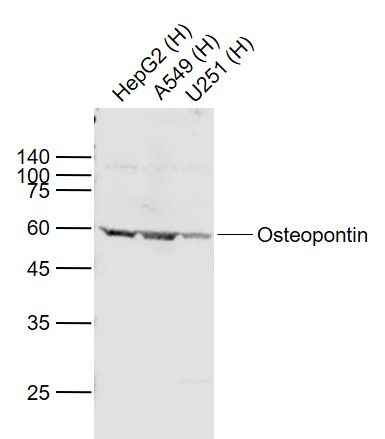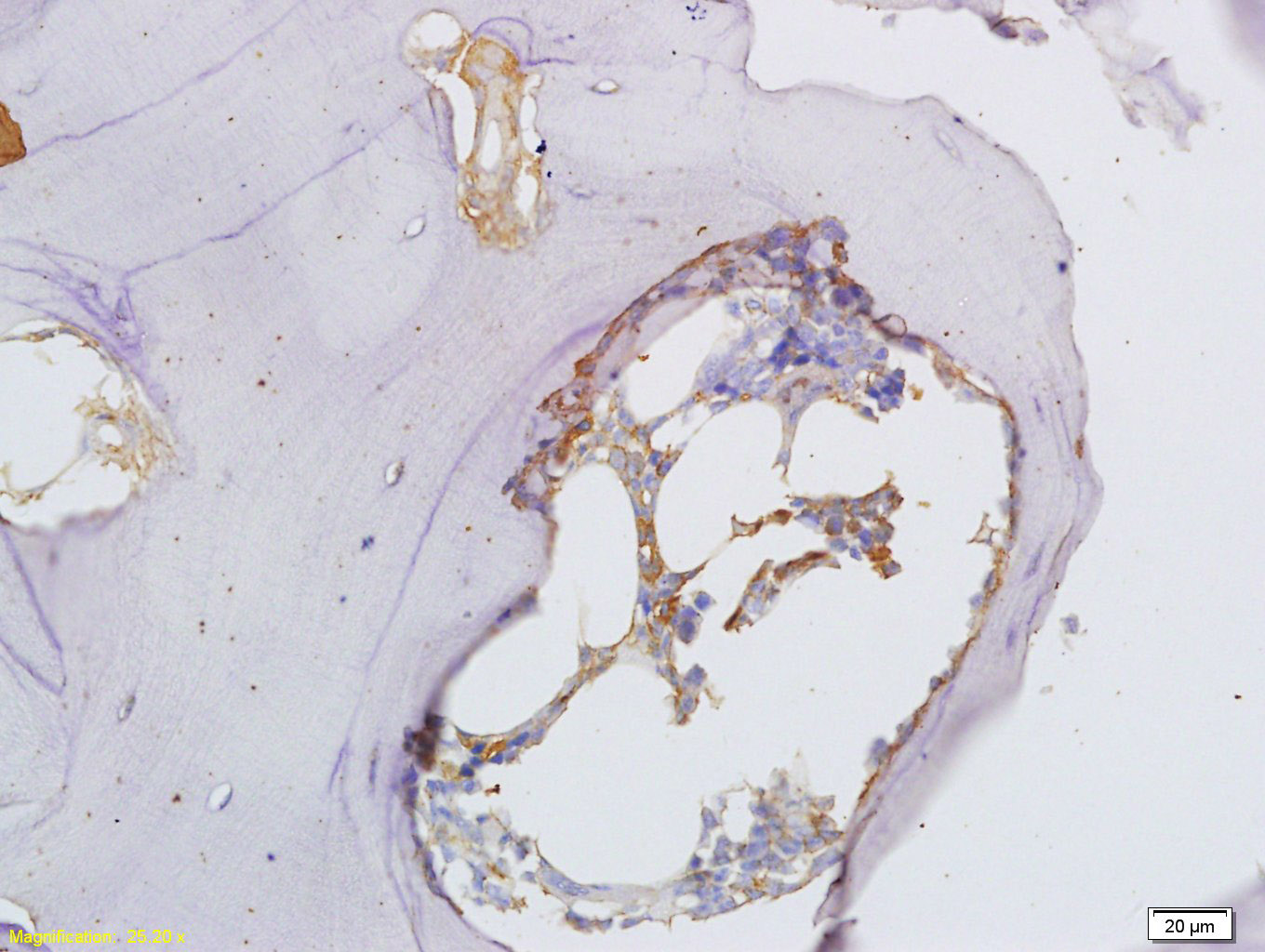Product Name :
Osteopontin polyclonal antibody Background :
Osteopontin (OPN), also designated bone sialoprotein 1, urinary stone protein, spp-1, Eta-1, nephropontin and uropontin, is an extracellular matrix cell adhesion phosphoglycoprotein. OPN is deposited into unmineralized matrix prior to calcification leading to localization at various tissue interfaces including cement lines, lamina limitans and between collagen fibrils of fully matured hard tissues. While OPN is a major product of osteoblasts, it is also synthesized by brain and kidney cells. OPN isolated from or secreted by various tissues ranges in molecular weight due to posttranslational modifications. OPN functions as a substrate for transglutaminase and is involved in cell adhesion, chemoattraction and immunomodulation. Product :
Rabbit IgG, 1mg/ml in PBS with 0.02% sodium azide, 50% glycerol, pH7.2 Storage&Stability :
Store at +4°C after thawing. Aliquot store at -20°C or -80°C. Avoid repeated freeze / thaw cycles. Specificity :
Osteopontin polyclonal antibody detects endogenous levels of Osteopontin protein. Immunogen :
Peptide Conjugate :
Unconjugated Modification :
Unmodification
Osteopontin polyclonal antibody Background :
Osteopontin (OPN), also designated bone sialoprotein 1, urinary stone protein, spp-1, Eta-1, nephropontin and uropontin, is an extracellular matrix cell adhesion phosphoglycoprotein. OPN is deposited into unmineralized matrix prior to calcification leading to localization at various tissue interfaces including cement lines, lamina limitans and between collagen fibrils of fully matured hard tissues. While OPN is a major product of osteoblasts, it is also synthesized by brain and kidney cells. OPN isolated from or secreted by various tissues ranges in molecular weight due to posttranslational modifications. OPN functions as a substrate for transglutaminase and is involved in cell adhesion, chemoattraction and immunomodulation. Product :
Rabbit IgG, 1mg/ml in PBS with 0.02% sodium azide, 50% glycerol, pH7.2 Storage&Stability :
Store at +4°C after thawing. Aliquot store at -20°C or -80°C. Avoid repeated freeze / thaw cycles. Specificity :
Osteopontin polyclonal antibody detects endogenous levels of Osteopontin protein. Immunogen :
Peptide Conjugate :
Unconjugated Modification :
Unmodification
-
 Immunohistochemical analysis of paraffin-embedded human liver cancer tissue using anti-Osteopontin antibody. Counter stained with hematoxylin.
Immunohistochemical analysis of paraffin-embedded human liver cancer tissue using anti-Osteopontin antibody. Counter stained with hematoxylin. -
 Immunohistochemical analysis of paraffin-embedded human kidney tissue using anti-Osteopontin antibody. Counter stained with hematoxylin.
Immunohistochemical analysis of paraffin-embedded human kidney tissue using anti-Osteopontin antibody. Counter stained with hematoxylin.
Bioworld Biotech only provide peptides for our antibodies and do not provide additional peptide customization services.
Price/Size :
USD 368/1mg/vial
Tips:
For phospho antibody, we provide phospho peptide(0.5mg) and non-phospho peptide(0.5mg).Describe :
Blocking peptides are peptides that bind specifically to the target antibody and block antibody binding. These peptide usually contains the epitope recognized by the antibody. Antibodies bound to the blocking peptide no longer bind to the epitope on the target protein. This mechanism is useful when non-specific binding is an issue, for example, in Western blotting (WB) and Immunohistochemistry (IHC). By comparing the staining from the blocked antibody versus the antibody alone, one can see which staining is specific; Specific binding will be absent from the western blot or IHC performed with the neutralized antibody.Formula:
Synthetic peptide was lyophilized with 100% acetonitrile and is supplied as a powder. Reconstitute with 0.1 ml DI water for a final concentration of 10 mg/ml.The purity is >90%,tested by HPLC and MS.
Storage:
The freeze-dried powder is more stable. For short time at 2-8°C. For long term storage store at -20°C.
Note :
This product is for research use only (RUO only). Not for use in diagnostic or therapeutic procedures.
 Osteopontin polyclonal antibody
Osteopontin polyclonal antibody  Datasheet
Datasheet COA
COA MSDS
MSDS SHIP
SHIP